Care
Despite the unpretentiousness of Thunberg's spirea, she still needs care. Planting the shrub correctly will ensure that the snow willow grows seamlessly and blooms without any extra care. In order for the culture to be more magnificent, bloom profusely and delight for a long time with its presence on the site, the following activities will be required:
- watering;
- soil mulching;
- fertilizer;
- weeding and loosening of the soil;
- pruning;
- preparation of the bush for wintering.
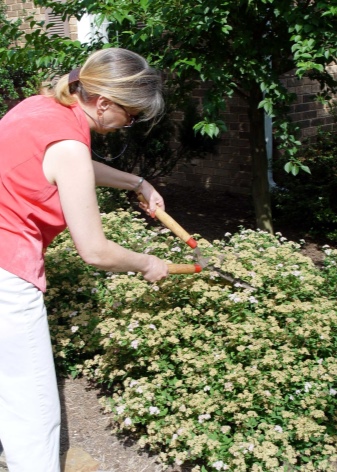
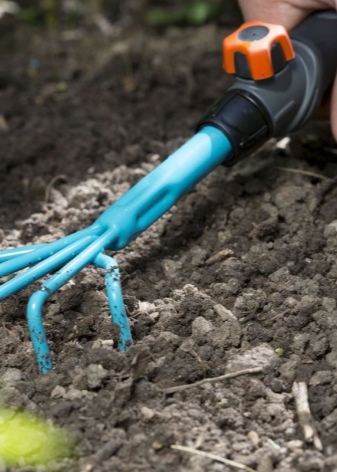
Often, irrigation of the snow willow is not required; it has enough atmospheric precipitation. It is recommended to irrigate young plantations or bushes that suffer from drought. To maintain a normal level of soil moisture, up to 2 buckets of liquid must be poured into the root zone.
If the spirea is planted in an area with fertile loose soil, then it does not need to be fertilized. Poor soil should definitely be fed.

Spirea feeding scheme.
- In early spring, the bush is fertilized with nitrogen-based substances. Urea and nitroammofoska stimulate the growth of shoots and its green mass. Alternatively, you can add organic matter, for example, manure or humus.
- At the beginning of summer, it is worth using a complex potash or phosphorus fertilizer. In this case, potassium sulfate or superphosphate is used. Top dressing of this species stimulates the abundance of flowering of the snow willow.
- At the end of summer. To prepare the plant for the winter period, it needs to be fed with potash or phosphorus fertilizer.
Spirea bushes tolerate pruning well. By trimming the shrub, you can make it lush and more well-groomed. Pruning dry and damaged shoots prevents the onset of many diseases.
Japanese spirea - care and cultivation
The Japanese spiraea plant belongs to the summer-flowering variety of deciduous shrubs that do not lose their attractive appearance all season. Even after the foliage has fallen, its bare branches do not look poor, attracting the eyes with a felt pubescence. The positive quality of this culture is that it coexists with other plantings without serious problems. Depending on the design tasks set, you can pick up bushes of different heights; in many forms of spirea, the Japanese crown is capable of changing the color of the foliage during the summer.
Japanese spirea in landscape design
Before purchasing new horticultural crops, it is advisable to study the most profitable ways to use them in landscape design in order to determine the planting site. Due to the presence of several forms at once spirea garden japanese suitable for solving many interesting tasks, both for creating solo and group compositions. Let's look at the popular options for using this wonderful plant in a country cottage:
- The Japanese spirea hedge always looks great.
- The compact forms of this plant elegantly complement the flowering perennials on the flower beds.
- Miniature Japanese spirea seems to be created for rock gardens and rockeries.
- This culture is suitable for framing garden ponds and paths.
- Spirea does not compete with conifers and looks great surrounded by thuja or firs.
- Tall varieties are a good solution for creating a solo composition.
- Spirea with colorful foliage is an excellent neighborhood for a shrub or tree with a standard discreet green crown.
Japanese spirea - varieties
There are about a hundred varieties of Japanese spirea and this list is regularly updated with original novelties. For convenience, gardeners classify them according to the shape of the crown, the strength of growth, the color of the foliage, the type of inflorescence and other decorative qualities.When planning the landscape on your site, it is advisable to consider the common and best varieties of Japanese spirea, which are optimal for garden compositions.
Popular forms of Japanese spirea:
- Macrophylla - bushes reach 1.3 m in height. A distinctive feature of the variety is variegated foliage, which changes color over time. When blooming, the crown acquires a purple-red color, then becomes greenish, and turns yellow in the fall.
- Shirobana - this spirea has small green leaves, does not exceed 0.8 m in height, well suited for rock gardens. Shirobana's flowers are of different colors, from snow-white to pink-red.
- Little princess - a low shrub up to 1.2 m, blooms with pink-red flowers, collected in small shield-like inflorescences.
- Candlelight - a plant up to 0.5 m tall, famous for its delicate yellowish foliage, against which pink inflorescences look great.
- Golden princess - bushes up to a meter tall with pinkish or yellowish foliage.
- Gold flame - another form of Japanese spirea with a pale yellow crown, which by autumn acquires a noble copper hue, with pinkish-red flowers.
- Gold mound - miniature form up to 25 cm tall with a golden crown.
- Crispa - a distinctive feature of the variety is serrated wrinkled leaves and relatively large crimson flowers.
Reproduction of spirea
Spireas can be propagated by seeds, cuttings and layering. Seeds ripened in hybrids (spireas of Van Gutt, Billard, Bumald, gray, Argut and all varieties) are not used, since the seedlings from them will be heterogeneous. Seeds are sown in early spring in boxes with an earthen mixture and 2-3 months after the emergence of shoots they dive into the garden bed, after having pinched the end of the main root for the development of a more powerful root system. Seedlings bloom 3-4 years after planting, all this time they need careful care - weeding, loosening the soil and frequent watering.
In order to fully preserve all the characteristics of the variety, the spirea must be propagated vegetatively - by cuttings or layering. Cuttings are cut from semi-lignified shoots of the current year with a length of 10 cm, both apical and from the middle part. To improve root formation, you can use "Kornevin" by dipping the ends of the cuttings into the solution just before planting. If cuttings are planted in July, good roots will have time to form by autumn.
If the number of new plants required is small, then you can use a reliable and non-troublesome method - propagation by layering. To do this, in the spring, during the blooming of the leaves, you need to bend the branches growing along the periphery of the bush to the ground, pin them with wire and sprinkle them with earth. You can also tie them to pegs, making the branches upright. If you keep the soil around the bush in a moderately moist state throughout the season, then by autumn or by next spring you can get independent plants. And if you remove the very first inflorescences on young bushes, then their development will go much faster.
Disembarkation and leaving rules
This variety is perfect for growing beginners due to simple agricultural technology and unpretentious care. In order for the shrub to feel great and please with its charming appearance, it is enough to follow simple rules.
The plant can fully develop in almost any soil, however, experts recommend growing it in a drained and moisturized one. Also sandy loam and loamy soils and a low acidity are great for spirea.
Goldmound loves warmth and moderate sunshine. Whenever possible, choose lighted locations for your garden culture. Lack of sunlight changes the color of the foliage from bright golden to light lime color.

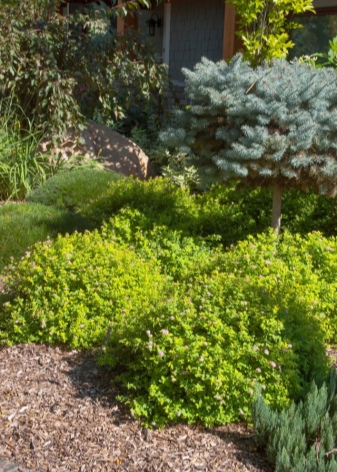
Seedling and plot preparation
If you are using ready-made seedlings for growing a plant, carefully assess their condition and get rid of unusable ones.Healthy and strong seedlings are characterized by green bark, moist roots and flexibility in the stem. The sections should be free of black spots and other marks.
Before planting in open ground, seedlings should be disinfected. So you protect the plant from possible diseases and minimize the risk of fungus. The treatment is carried out using a weak manganese solution.
If the root system is too long, it should be shortened using garden shears. The selected area should be carefully dug up a few weeks before transplanting and top dressing should be applied.
Shrub planting
Planting is recommended at the end of the first spring month.
The work is carried out as follows:
the optimal depth of the pit should be from 40 to 50 centimeters;
it is necessary to focus on the size of the roots, the hole is dug with a 20% free space;
at the bottom of the pit for planting, a drainage layer is made of gravel or pieces of brick;
the drainage is covered with a soil mixture, sand, peat and turf soil are mixed for its preparation, the soil is drawn up with a small slide;
seedlings are set on a hill, and the roots are distributed along the slopes;
the root system must be carefully sprinkled with earth and lightly tamped with the soil;
at the end of the work, the plant should be watered.

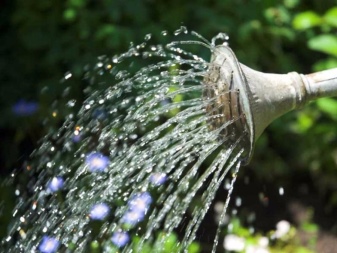
Watering and fertilizing
This representative of the flora has an average drought resistance. Shrubs need to be watered periodically, otherwise it will negatively affect their growth.
Many experienced gardeners recommend using fertilizers if the spiraea grows in poor soil. If the seedlings are planted in fertile soil, the spirea will delight with a dense crown even without additional fertilizing.
Mulch is also used to feed the root system.
Shrub pruning
Regular pruning is recommended to maintain an attractive appearance. The procedure is carried out approximately once a month. It should be noted that this excludes the subsequent flowering of the plant. When choosing a spirea for your garden, you should decide on the purpose of the plant and, depending on this, carry out pruning or not.
Sanitary pruning is done in order to maintain and maintain the shape of the crown. Weak, dry and damaged shoots should also be removed. Adult shrubs at the age of 4–5 years are treated more intensively than young plants. During work, 3-5 branches are removed from them to the base.
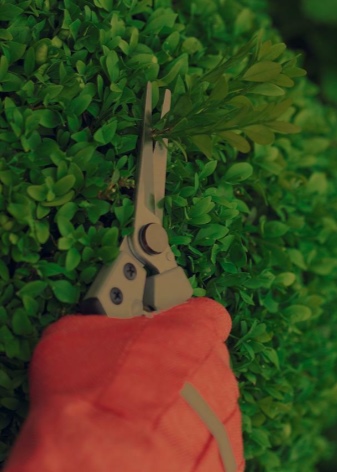
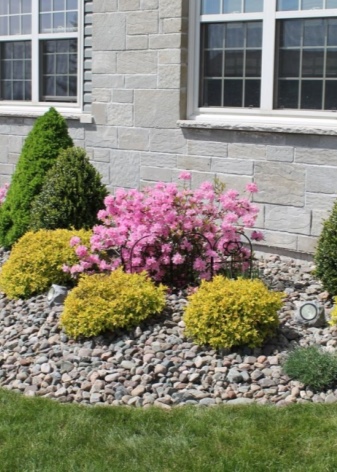
Diseases and pests
Spiraea pink is not particularly prone to disease and insect damage, but, unfortunately, this sometimes happens. Due to the high moisture content of the soil, the plant can be damaged by fungal diseases, among which the most common are gray mold and various spots. For treatment use fungicidal drugs ("Fitosporin", "Fundazol" or Bordeaux liquid), and also normalize soil moisture and the amount of watering.
Of the parasites, the spider mite inflicts severe damage to the bushes. Infection with it can be determined by the presence of tiny whitish specks on the leaf plates. Over time, damaged leaves turn yellow and dry out. The most common spider mite infestation occurs during drought.
Aphids are also problematic for shrubs. She feeds on the sap of the plant, making it weak. Protect the bush with "Kronefos", "Pyrimor" or "Fozalon". From folk remedies against aphids, onion peel tincture is used, which should be used at the beginning of the growing season. The infusion also has a beneficial effect on the soil, killing microorganisms and feeding them with vitamins.
Occasionally, the plant can damage the whitefly. Get rid of the pest with Fitoverm. This drug is also effective against rain snails; it is used as a preventive measure. The leafworm can also harm the spirea, caterpillars appear in late spring. They feed on inflorescences and buds, not only damaging the appearance of the bush, but also leading to flowering problems.It is necessary to get rid of the pest immediately, since the caterpillars multiply very quickly. As a preventive measure, the bushes are sprayed with special preparations every 15–20 days so that the leaf rollers do not have time to multiply. Against caterpillars, an infusion of leaves and flowers of field chamomile, to which soap is added, are also used. The bushes are sprayed several times after 10 days.
Reproduction
The most effective way to propagate the Goldmound variety is by cuttings. For this, both green and woody cuttings are suitable.

The breeding procedure in this case looks like this:
In summer, a young, non-flowering shoot is selected on the bush and incised at the base.
This cut is divided into several more pieces of 15 cm, no more.
The resulting cuttings are cleaned from the bottom of the leaves and buried in the ground. For this, it is better to use a greenhouse.
Plantings are covered with plastic wrap to create a greenhouse effect
In this case, it is important to make small holes in the shelter for air ventilation.
As the cuttings develop, they are regularly sprayed with a spray bottle.
In October, the planting material is moved to open ground.
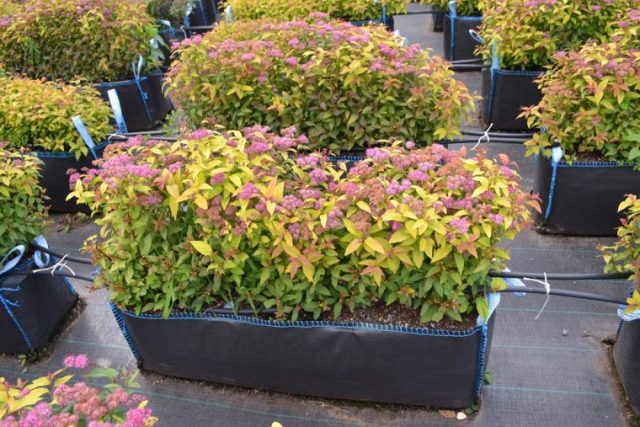
Young spireas can also be propagated by dividing the bush. Old bushes will not work for this.
The algorithm for dividing the bush is as follows:
- A young bush is dug out of the ground, focusing on the diameter of the crown. Damage to roots that are too long extending beyond the specified area is allowed. When removing the plants, they try not to destroy the earthen lump.
- Then the spirea is lowered into a bucket or basin of water for 1-2 hours. This is necessary in order to soften the earth, so it will be easier to clean the root system of the plant.
- The roots are watered with a hose, removing the earth from them, after which the spirea is taken out of the water and laid on its side.
- With a sharpened knife or garden shears, the common root system is divided into 2-3 equal parts. At the same time, each delenka should have a sufficient number of buds and approximately the same volume of roots.
- The resulting parts are planted in pre-moistened wells and sprinkled with earth.
- The near-stem section is lightly tamped and mulched.
Soon after planting, the cut takes root.
Seed reproduction occurs according to the following scheme:
- In spring, seeds are sown in wooden or plastic containers with pre-moistened soil. Recommended substrate composition: leafy soil and high peat, mixed in a 1: 1 ratio.
- The soil surface is mulched with peat for better moisture retention.
- After 8-10 days, the first shoots appear. They are immediately sprayed with "Fundazol" to protect against fungal infections.
- After 2-3 months, the seedlings are planted in separate containers.
- When the spirea seedlings form a full-fledged root system, they can be planted in open ground.
- To do this, they are taken out of containers and the roots are slightly shortened.
- Then the seedlings are buried in the dug up loose soil.
- Planting is watered and mulched.
After 1 year, the height of the seedling should reach 10-15 cm. In subsequent years, the rate of development of the shrub increases.

The necessary conditions
Despite the fact that this variety of birch spirea is quite easy to care for, you should carefully read the recommendations of experienced gardeners.
- Watering. Prolonged drought for Spirea birch-leaved "Thor" is destructive. For the bush to grow well, systematic watering is important. If it rains periodically in summer, then watering 2 times a month is quite enough. One plant requires 1-2 buckets of water, depending on its size. After irrigation, it is recommended to mulch or loosen the soil.
- Top dressing. Fertilizers should be applied several times per season. It is advisable to carry out the first feeding after spring pruning, using humus or mullein infusion with the addition of 10 g of superphosphate. In late May - early June, it is recommended to apply potassium-phosphorus fertilizers. You can use any complex preparations for flowering shrubs.In autumn, it is necessary to mulch the trunk circle with humus, peat or leaves.
- Pruning. This procedure is recommended in early spring before the kidneys awaken. All old shoots (6-8 years old) should be removed by pruning them near the ground, bearing in mind that the upper bud should grow outward. Young branches are pruned, collecting them in a bunch in order to properly form the crown. After five years of age, the stems of the shrub are cut to a height of 30 cm from the ground, this enhances the branching and density of the spirea. After flowering, it is imperative to remove wilted peduncles.
- Wintering. It is recommended to cut off damaged branches after the end of the leaf fall. This variety does not require special shelter in winter. However, the bush must be mulched with humus or peat, this will be not only protection, but also top dressing. To avoid damage from the invasion of large rodents, a special protective net should be installed in advance.
- Pests and diseases. The delicate leaves of spirea can be affected by aphid colonies that feed on plant sap, and whitish spots on the leaves indicate a spider mite attack. In addition, the whitefly, leafworm, multi-colored miner can harm the shrub. Acaricides should be used against ticks, and Fitoverm, Decis and other insecticides should be used against insects. Spiraea birch-leaved "Tor" is rarely affected by fungi, but if damage to branches or leaves with gray mold is found, it is recommended to treat the plant with fungicides, for example, "Fitosporin-M", "Ditan M-45". Spring spraying of the bushes with Bordeaux mixture serves as the prevention of fungal diseases.
Planting and caring for the Japanese Goldmound spirea
Planting a Goldmound spirea and the subsequent care of the plant is not difficult. This horticultural crop is undemanding to the composition and quality of the soil, although it prefers well-drained moderately moist soils. The variety grows best on loamy and sandy loam soil of low acidity, but it also develops well on other types.
Spirea Goldmound is thermophilic, therefore, when choosing a place for planting a shrub, one should focus on well-lit areas. With a lack of light, the bush changes its color from rich golden to light green.
Preparation of planting material and site
Spirea seedlings must be carefully inspected before planting and unsuitable ones should be set aside. Healthy plants bend easily, have a greenish bark and moist roots without black spots on the cuts.
Immediately before planting, the planting material is compulsorily disinfected - this will help to reduce the risk of disease of the bush with a fungus to a minimum. A weak solution of potassium permanganate is used for disinfection.
The area chosen for planting the spirea is dug up 1-2 weeks before and organic fertilizers are applied to the soil.
Planting rules for Spirea Goldmound
Planting of the Goldmound variety spirea in open ground is carried out at the end of March. The procedure is very simple:
- In a previously prepared area, a hole is dug with a depth of about 40-50 cm. In this case, one should be guided by the size of the root system of the bush - the hole is dug with a margin of about 20%.
- Drainage in the form of broken bricks or gravel is placed at the bottom of the planting pit.
- A soil mixture of peat, sand and sod land is placed on top of the drainage, and a small hill is formed from it.
- A seedling is placed on this hill and the roots of the spirea are spread along its slopes.
- Then the root system is sprinkled with the top layer of soil from the site.
- Planting ends with moderate watering.
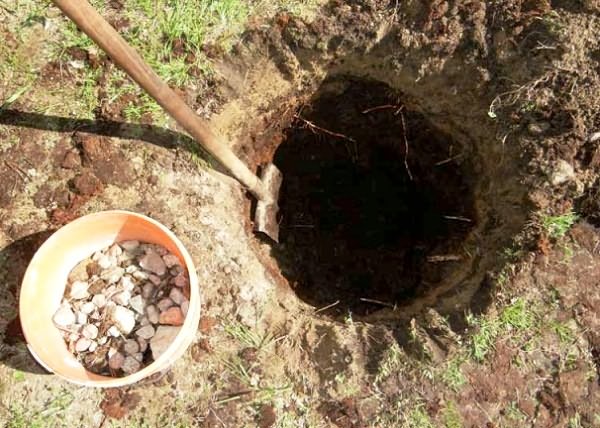
Watering and feeding
The drought resistance of the variety is average, so the spirea bushes need to be watered regularly. Otherwise, the drying out soil will inhibit the growth of the shrub.
Spirea is fed mainly on poor soils. When planted in fertile soil, the variety develops well without additional processing of the site.
Special mulching compositions or organic fertilizers are used as top dressing.They are brought into the ground once a year - in the spring.
Pruning
It is recommended to prune the Goldmound spirea once every 30-40 days, however, this procedure automatically excludes the subsequent flowering of the bush. That is why, before planting a shrub, it is necessary to determine its role. Profusely flowering forms are not pruned, unlike decorative deciduous ones.
Sanitary pruning is done to preserve the shape of the bush. For this, only dry and broken branches are removed. Healthy shoots are not touched.
You can learn more about the features of trimming the spirea from the video below:
Preparing for winter
All varieties of spirea are considered fairly cold-resistant plants. Nevertheless, it is recommended to cover young seedlings for the winter, since they are still weak and unable to winter safely without protection.
Dry leaves or sawdust are used as a shelter, with which the shoots bent to the ground are sprinkled with a layer of up to 15 cm.


